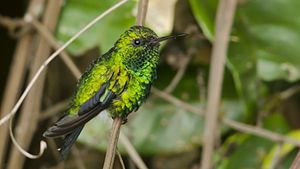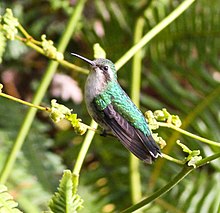Gibson's Emerald Hummingbird
| Gibson's Emerald Hummingbird | ||||||||||
|---|---|---|---|---|---|---|---|---|---|---|

Gibson's Emerald Hummingbird ♂ |
||||||||||
| Systematics | ||||||||||
|
||||||||||
| Scientific name | ||||||||||
| Chlorostilbon gibsoni | ||||||||||
| ( Fraser , 1840) |
The Gibson's Emerald Hummingbird ( Chlorostilbon gibsoni ) or Red-billed Hummingbird is a species of bird from the hummingbird family (Trochilidae). The species occurs in Colombia and Venezuela . The IUCN assesses the population as Least Concern .
features

The Gibson's Emerald Hummingbird reaches a body length of about 7.6 cm, with the straight beak about 1.3 cm. The male's lower beak is predominantly red, while that of the female is red only at the base. The upper side of the male is colored dark green bronze, while the upper part of the head is only slightly glistening. The sides of the head and the underside are glittering and the tint varies from green to golden green. The strongly forked tail is steely blue-black. In the wild, the females can hardly be distinguished from the females of the blue-tailed emerald hummingbird ( Chlorostilbon mellisugus ( Linnaeus , 1758)). The top of the females glistens copper green. The dark ear covers are bordered by a noticeable white stitch behind the eyes. The underside is pale gray. The right-angled to slightly forked tail is steely blue-black with narrow gray-white speckles. The base of the tail feathers is gray.
behavior
As "trapliners" they regularly fly to very specific, scattered flowers in quick succession.
Reproduction
In a research work by the Universidad Nacional de Colombia in the Departamento de Cundinamarca , its nest was described as a drooping chalice. In the north of Colombia and in the Departamento del Huila it has been observed in a breeding mood from March to August.
distribution and habitat
They occur rarely but in some areas often in dry forests, bushy semi-open landscapes and cultivation areas with dry scrub. In the dry season between December and April, they are much more common in Parque Nacional Natural Tayrona . They occur in the Sinú Valley at altitudes around 500 meters and in the drier areas of the middle and upper valley of the Río Magdalena and the east of Zulia at altitudes up to 2300 meters.
Subspecies
There are three known subspecies:
- Chlorostilbon gibsoni gibsoni ( Fraser , 1840) - The nominate form occurs in the valley of the upper reaches of the valley of the Río Magdalena in central Colombia.
- Chlorostilbon gibsoni chrysogaster ( Bourcier , 1843) - This subspecies occurs from Cartagena to Santa Marta in northern Colombia.
- Chlorostilbon gibsoni nitens Lawrence , 1861 - This subspecies is common in northeastern Colombia and northwestern Venezuela.
The Gibson's emerald hummingbird has long been considered a subspecies of the blue-tailed emerald hummingbird. It was only analyzes by Frank Garfield Stiles III that led the South American Classification Committee (SACC) to split off the species.
Etymology and history of research
Louis Fraser described the Gibson's emerald hummingbird under the name Trochilus Gibsoni . For the description he used a manuscript by George Loddiges . He did not provide any information about the location. It was John Gould who introduced the new genus Chlorostilbon in 1853 . Only later was the Gibson's Emerald Hummingbird assigned to this genus. "Chlorostilbon" is made up of the Greek words "chlōros χλωρός " for "green" and "stilbōn στίλβων " for "shining". The Greeks gave Mercury the nickname Stilbōn, which is due to the verb "stilb" for "blink". The additional species »gibsoni« was dedicated to the British horticulturist John Gibson (1815–1875). "Nitens, nitentis, nitere" is of Latin origin and means "glittering, shimmering, shimmering". "Chrysogaster" is a Greek word made up of "chrysos, χρυσος " for "gold" and "gastēr, gastros γαστηρ, γαστρος " for "belly".
literature
- Steven Leon Hilty , William Leroy Brown : A guide to the birds of Colombia . Princeton University Press, Princeton 1986, ISBN 0-691-08372-X ( books.google.de ).
- Frank Garfield Stiles III: A new species of emerald hummingbird (Trochilidae: Chlorostilbon) from the Sierra de Chiribiquete, southeastern Colombia, with a review of the C. mellisugus complex. In: The Wilson Bulletin . tape 108 , no. 1 , 1996, p. 1–27 ( sora.unm.edu [PDF; 1.6 MB ]).
- Antonio Olivares: Aves de Cundinamarca . Universidad Nacional de Colombia, Bogotá 1969 ( books.google.de ).
- James A. Jobling: Helm Dictionary of Scientific Bird Names . Christopher Helm, London 2010, ISBN 978-1-4081-2501-4 .
- Louis Fraser: Mr. Fraser pointed out the character of several new species of Humming-birds, which have been placed in his hands by Earl of Derby for this purpose, and that they might be exhibited at one of the Society's scientific meetings. In: Proceedings of the Zoological Society of London . tape 8 , no. 86 , 1840, pp. 14-19 ( biodiversitylibrary.org ).
- Jules Bourcier: Oiseaux-mouches nouveaux . In: Revue Zoologique par La Société Cuvierienne . tape 6 , 1843, pp. 99-104 ( biodiversitylibrary.org ).
- George Newbold Lawrence: Description of Three New Species of Birds . In: Annals of the Lyceum of Natural History of New York . tape 7 , 1861, p. 303-305 ( biodiversitylibrary.org ).
- John Gould: A monograph of the Trochilidæ, or family of humming-birds . tape 5 , delivery 5. Taylor and Francis, London 1853 ( biodiversitylibrary.org ).
- Frederick Herschel Waterhouse: The dates of publication of some of the zoological works of the late John Gould, FRS RH Porter, London 1885 ( biodiversitylibrary.org ).
Web links
- Chlorostilbon gibsoni inthe IUCN Red List of Endangered Species 2017.1. Posted by: BirdLife International, 2016. Retrieved August 28, 2017.
- BirdLife International: Species Factsheet - Red-billed Emerald ( Chlorostilbon gibsoni ) . Retrieved August 28, 2017.
- Videos, photos and sound recordings for Red-billed Emerald (Chlorostilbon gibsoni) in the Internet Bird Collection
- Gibson's Emerald Hummingbird ( Chlorostilbon gibsoni ) at Avibase; accessed on August 28, 2017.
- Chlorostilbon gibsoni in the Integrated Taxonomic Information System (ITIS)
- xeno-canto: Sound recordings - Red-billed Emerald ( Chlorostilbon gibsoni )
- Gibson's Emerald Hummingbird (Chlorostilbon gibsoni) in the Encyclopedia of Life . Retrieved August 28, 2017.
Individual evidence
- ↑ a b c d Steven Leon Hilty u. a., p. 265.
- ^ Antonio Olivares, p. 181.
- ^ IOC World Bird List Hummingbirds
- ↑ a b Louis Fraser, p. 17.
- ↑ Jules Bourcier, p. 101.
- ↑ George Newbold Lawrence, p. 305.
- ^ Frank Garfield Stiles (1996).
- ^ Proposal (# 54) to South American Classification Committee
- ^ John Gould, plate 355 plus text
- ↑ James A. Jobling, p. 103.
- ↑ James A. Jobling, p. 173.
- ↑ James A. Jobling, p. 273.
- ↑ James A. Jobling, p. 105.
Remarks
- ↑ According to Frederick Herschel Waterhouse p. 47, plate 355 appeared as part of delivery 5 from 1853. Here Gould assigned Chlorostilbon prasinus , a synonym for the blue-tailed emerald hummingbird, to the genus.
